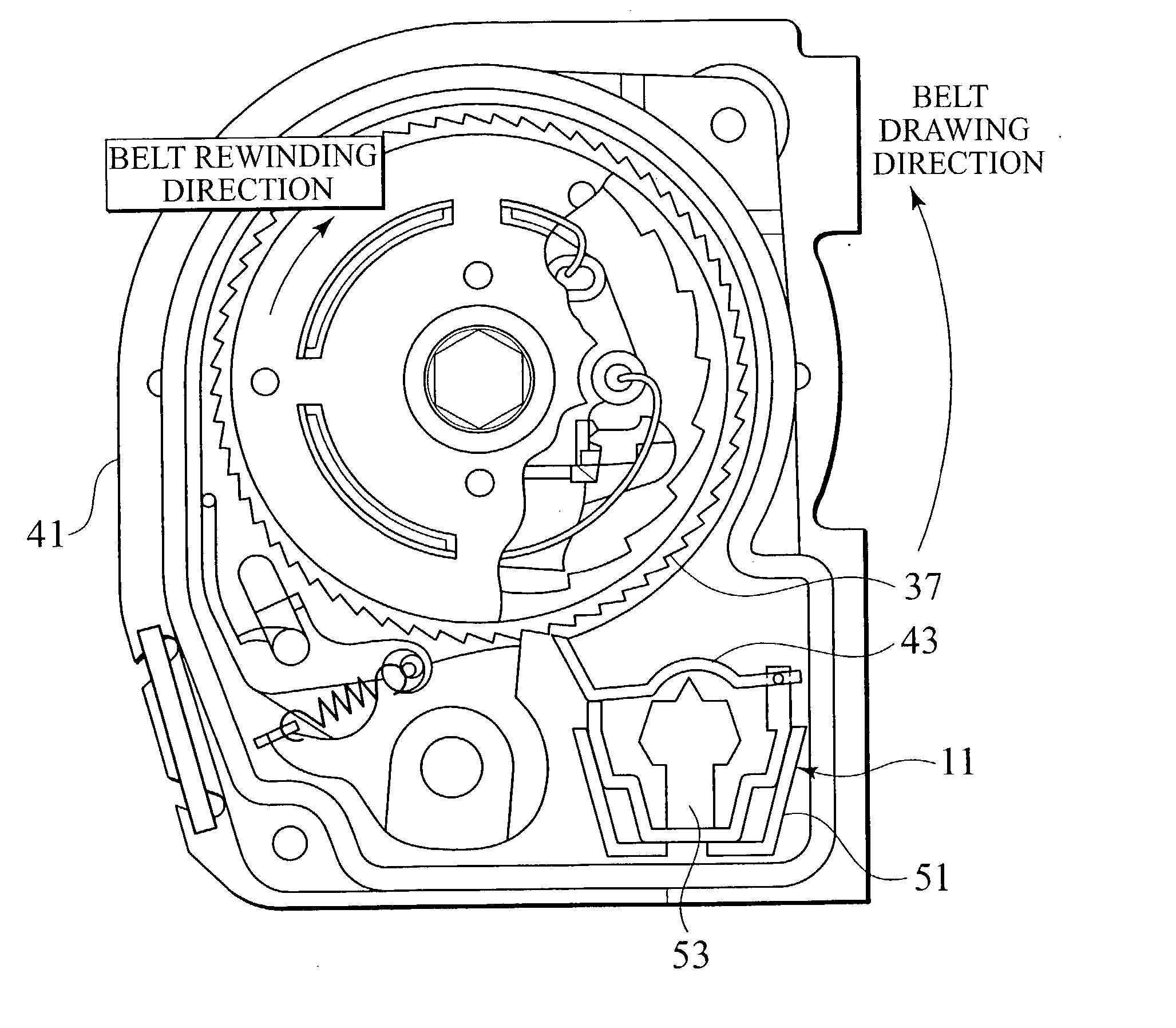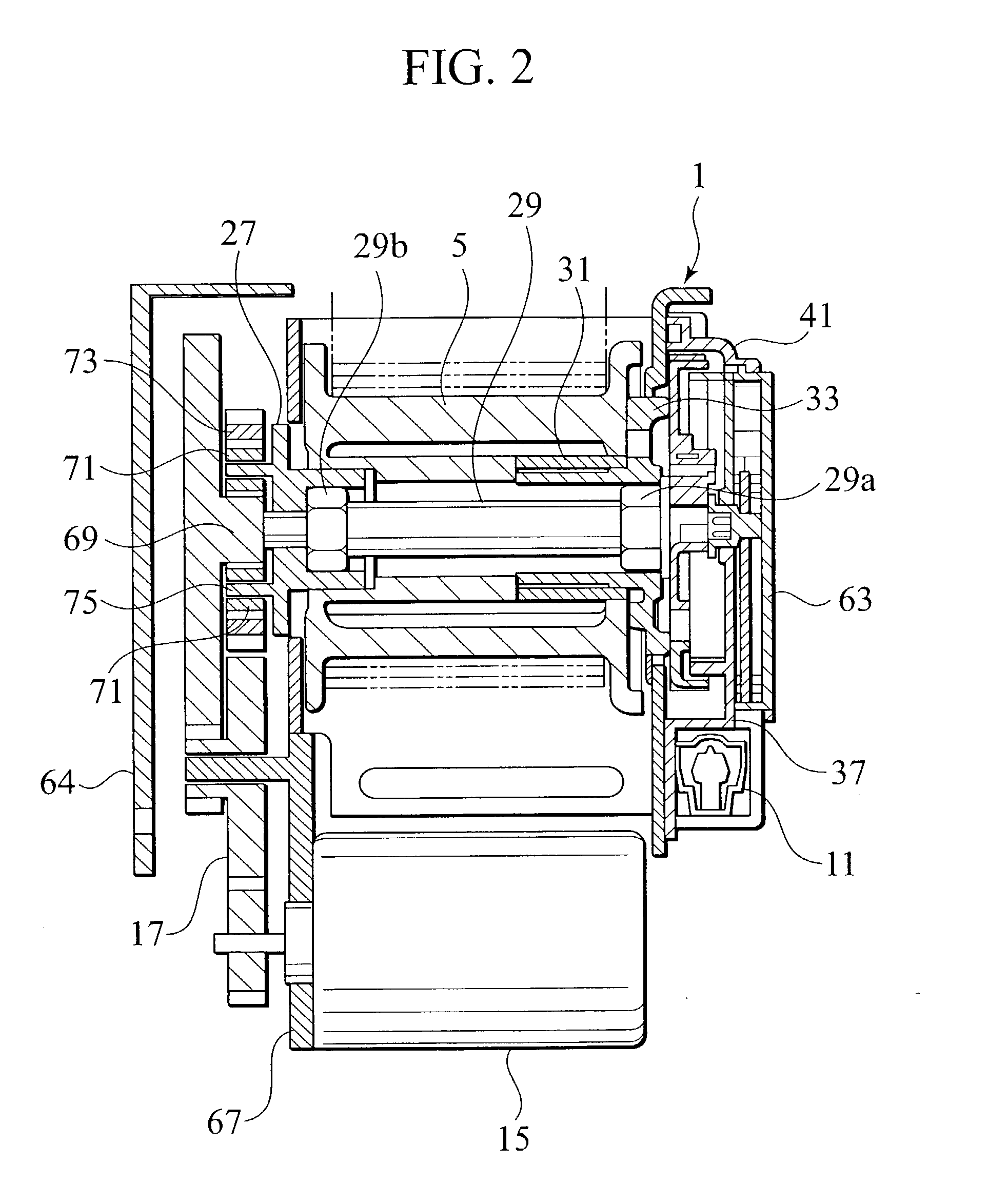Seatbelt apparatus for vehicle
- Summary
- Abstract
- Description
- Claims
- Application Information
AI Technical Summary
Benefits of technology
Problems solved by technology
Method used
Image
Examples
first embodiment
[0041] FIG. 1 is an exploded perspective view of a seatbelt apparatus for a vehicle, in accordance with the present invention. FIG. 2 is a longitudinal sectional view of the same apparatus in its assembled state. It is assumed here that the shown seatbelt apparatus is applied to each of a driver seat and an assistant driver's seat in one form of another seat except the driver seat.
[0042] As shown in FIG. 1, the seatbelt apparatus generally includes a frame 1, a reel 5 for rewinding a seatbelt 3, a lock mechanism 7 arranged on one side of the frame 1 (front side of FIG. 1) to retard the rotation of the reel 5 in a direction .alpha. to draw the seatbelt 3 from the reel 5, a lock actuating mechanism 9 for actuating the lock mechanism 7 as occasion demands, an acceleration sensing mechanism 11, a force limiting (EA) mechanism 13, a motor 15 arranged on the other side of the frame 1 (back side of FIG. 1) to generate a belt rewinding torque, a reduction gear 17 for reducing a torque of th...
second embodiment
[0098] The operation of the second embodiment will be described with reference to FIGS. 17 to 19.
[0099] FIG. 17 shows an overall flow chart for carrying out a program of the second embodiment. First of all, when the ignition switch 103 is turned on, the program is started. At step 1701, it is executed to input the signals from the fore-and-aft acceleration (longitudinal acceleration) sensor 97 and the left-and-right acceleration (lateral acceleration) sensor 99. Next, at step 1703, it is executed to perform an assistant driver's seat control mentioned later. Continuously, at step 1705, it is executed to perform a driver seat control also mentioned later. At step 1707, it is executed to judge whether the ignition switch 103 is turned off or not. If the judgment at step 1707 is Yes (i.e. turn-off), then the routine of the program is ended. While, if the judgment at step 1707 is No (i.e. turn-on), then the routine returns step 1701 to input the signals from the sensors 97, 99.
[0100] FI...
third embodiment
[0117] FIG. 22 shows an overall flow chart for carrying out the above control program of the First of all, when the ignition switch 103 is turned on, the program is started. At step 2201, it is executed to input the signal from the fore-and-aft acceleration (longitudinal acceleration) sensor 97. Next, at step 2203, it is executed to calculate a rising value of the fore-and-aft acceleration (i.e. rise of longitudinal acceleration: .DELTA.longitudinal acceleration). Continuously, at step 2205, it is judged whether the seatbelt control system for the assistant driver's seat is not under control now.
[0118] If the judgment at step 2205 is Yes (not under control), then the routine goes to step 2207 to carry out the operation to rewind the seatbelt in accordance with a flow chart of FIG. 23.
[0119] In the flow chart of FIG. 23, at step 2301, it is executed to compare a value of the longitudinal acceleration with a threshold value Gx3. When the longitudinal acceleration is smaller than the ...
PUM
 Login to View More
Login to View More Abstract
Description
Claims
Application Information
 Login to View More
Login to View More - R&D
- Intellectual Property
- Life Sciences
- Materials
- Tech Scout
- Unparalleled Data Quality
- Higher Quality Content
- 60% Fewer Hallucinations
Browse by: Latest US Patents, China's latest patents, Technical Efficacy Thesaurus, Application Domain, Technology Topic, Popular Technical Reports.
© 2025 PatSnap. All rights reserved.Legal|Privacy policy|Modern Slavery Act Transparency Statement|Sitemap|About US| Contact US: help@patsnap.com



